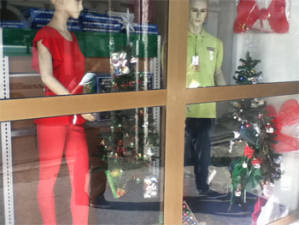Going from and to Cuba for Xmas
Graham Sowa

During the cold war a lot of lies were told. I’m pretty sure one of those lies was that communists do not celebrate Christmas. I can say that is a lie because while walking along Carlos the 3rd street the other week I saw a store with a window display of Christmas trees and decorations.
Of course the store was one of those that sell items in hard currency (convertible pesos), which pretty much means that in Cuba Christmas comes with a price tag. Just like in the United States.
One of the pricier items on the top of the wish list for Cubans and Cuban-Americans is a plane ticket to travel and be with family.
In the United States Christmas is one of the few times a year where pretty much everyone can be assured a break from work so the whole family can gather. Of course as our rampant consumerism demands ever longer store hours and services (including Christmas day) even once a year family gatherings are interfered with by work demands.
This will be the first Christmas I have spent in the United States in several years, and I’m excited to spot any changes in how North Americans are celebrating our favorite holiday.
I will be joining the multitudes that have paid about $400 USD for the 35 minute flight between Miami and Havana. All of the direct flights between Miami and Havana leave and arrive at the brand new Terminal 2 at the Jose Martí international airport. I have memory of that experience from this summer when I traveled home.
I remember being in a line to get on a bus to take us to the plane. No one was using the “último!” system, people were just joining the line with their families as they arrived. The line grew from the front. When we got on the bus everyone stopped walking as soon as they stepped in the door.
Pretty soon the front of the bus was full and no one could pass it to get to the back of the bus which was completely empty.

Anyone who has spent just one day using public transportation in Cuba would know that you always walk to the back of the bus (unless you are pregnant, with an infant, or injured/disabled) so the bus fills up from the back to the front.
Obviously not all of these people at the airport, traveling to the United States, were the type of Cubans that take public transportation.
I also wondered if they had gone thought he same process I had to in order to buy my ticket, as it is very different depending if you are buying the ticket in the United States or Cuba.
In the United States there are almost a dozen charter companies that offer direct flights between Cuba and the United States for Cuban-Americans and holders of travel licenses. Most of the charter companies have the same price, but some of them are a bit cheaper or a little more expensive than the others.
The process of buying a ticket is just short of archaic. It involves filling out 3 or 4 forms and signing an affidavit. The check in process at the US airport for the Havana flights is so far from the 21st century that it belongs in a history of transportation museum.
In Cuba the process of buying a ticket comes with one option: HavanaTur. HavanaTur is a state-run company that sells the tickets in partnership with all of the United States based charters. The price is fixed and only changes 3 or 4 times a year. The tickets are written out by hand, and the traveler must present themselves in person at the HavanaTur office to buy the ticket. Bring cash.
In the United States there are many charter companies competing for customers. In Cuba there is just one travel agency. Is it possible that the cooperation between these free-enterprise airlines and the state controlled travel agency proves that socialism has room for capitalism and capitalism has room for socialism?
Or does it prove that the systems are much more similar to each other than we assume? In either case it is the Christmas season, and the consumer will pay.





